Dignities & Ancient
Planetary Sects

This object contains information about the sect of the seven traditional planets for the current chart. The first column shows the planetary glyph and its inherent nature. The “Cht” column shows whether the chart is diurnal or nocturnal (i.e. whether the sun is above the horizon or not, and is therefore the same for all rows in the table). The “Plc” column shows whether that planet is in a diurnal or nocturnal placement (i.e. whether it is in the same hemisphere as the sun). The “Sgn” column shows whether that planet is in a diurnal (masculine) or nocturnal (feminine) sign. If the planet’s inherent nature concurs with chart, placement, and sign, then it has a dignity know as “In Hayz”. If it s nature opposes all of them, then it is “Ex Conditione”, which is a form of negative dignity.
Essential Dignities
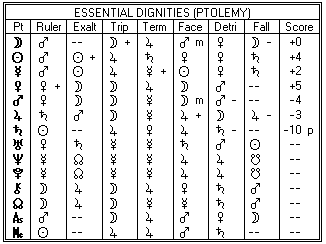
This object lists the traditional essential dignities for each of the displayed points in the chart. The scores are normally calculated according to the default dignity scores stored in the file essdig.alm, which resides in Solar Fire’s system folder. Optionally you may select the name of another dignity scoring file to use instead. The columns contained in this table are as follows:
•Pt - Point’s glyph or symbol
•Ruler - Planet which is in rulership at this point’s zodiacal position
•Exalt - Planet which is in exaltation “
•Trip - Planet which is the triplicity ruler “
•Term - Planet which is the term ruler “
•Face - Planet which has its face “
•Detri - Planet which is in detriment “
•Fall - Planet which is in fall “
•Score - Total dignity score (an a “p” flag denoting whether this point is in peregrine)
A plus sign (+) in a column indicates that the point is in its own dignity. A minus sign (-) indicates that the point is in its own fall or detriment. An “m” indicates that the point is in mutual reception with another point for that form of dignity.
Dignity/Almuten scores

This object displays planetary scores for various dignity or almuten calculations. The scores are normally calculated according to the default dignity and almutens scores stored in the file general.alm, which resides in Solar Fire’s system folder. Optionally you may select the name of another dignity or almuten scoring file to use instead. Each dignity or almuten definition requires 3 data lines (hence if the dignity definition file contains 3 definitions, then 9 data lines are required). The first line displays a description of the scoring method. The second line displays the list of planets (highest scoring first, lowest scoring last), and the third lines displays the numerical score values under each planet.
Planetary Hour/Day

This object shows the planet of the day and hour of the current chart, and which hour of day or night is current. (These hours are not hours of 60 minutes each, but instead are exact divisions of 12 into the length of time of day or night.) The bottom two rows indicate how long since the last planetary hour was in effect, and how long until the next planetary hour takes effect, and what planets are involved.
Mutual Receptions
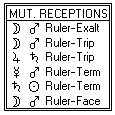
This object lists planetary mutual receptions and cross-receptions found within the current chart. Items are listed in the order Rulership, Exaltation, Triplicity, Term and Face, but are limited to the number of data lines specified for this object.
Horary Considerations

This object lists certain pre-defined criteria that are used in evaluating horary charts. These criteria are i) Moon void of course, ii) Moon in via combusta, iii) ASC in via combusta, iv) ASC near a sign boundary, v) Saturn in 7th house or conjunct Descendant v) Moon fast or Moon slow. If none of these conditions are present in the chart, then the word “None” appears in the box.
Firdaria
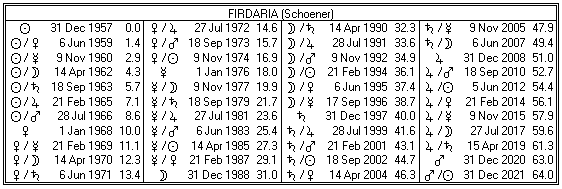
This object lists the starting dates of planetary periods and the ages of the individual at each of these dates. The number of planetary periods covered depends on the number of data lines selected for the object. For example, 44 data lines will cover 64 years from birth, and 60 lines will cover 86 years from birth. There are two variants of this object, one using planetary periods as they were used by Al Biruni and Schoener, and the other is a variant of this which places the nodes in a different order for night-time charts. (The variants give identical results for daytime charts.)
Planetary 36Yr Cycle

This object displays the same information as the Planetary Hour/Day object, but also indicates the current planetary rulers of a 36 year cycle. Each 36 year period is ruled by one of the 7 planets from Mars to Neptune, and each year within that 36 year period is sub-ruled by a planet. The periods of rulership start on the tropical Aries ingress each year. This 36 year cycle is described in American Astrology Magazine - Year 1940, in an article by David Anrias (although it is referred to in that article as a 35 year cycle), and is also alluded to in the title of the book “The Initiate in the Dark Cycle” by Cyril Scott – Publ. Samuel Weiser Inc. This “Dark Cycle” is the 36 year period from 1909 to 1945 which was ruled by Mars.
Arabic Lunar Mansions

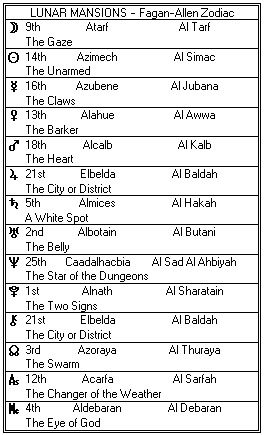
This lists, for each displayed point, the number of the Arabic mansion it occupies (1 to 28), the name of the mansion as given in the Picatrix, the Arabic name, and the English name.
Direction of Divisions (Term Directions)
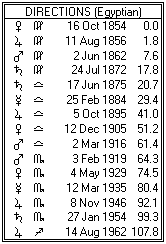
This object lists the starting dates of planetary term periods and the ages of the individual at each of these dates, according to the primary direction of the Ascendant of the birth chart by oblique ascension. The number of planetary periods covered depends on the number of data lines selected for the object. For example, 15 data lines will cover about 90 years from birth. The type of terms used (either Ptolemaic or Egyptian) can be chosen by specifying a dignity file that has the required type of term selected in its first definition.
Chart Hylegs

This object lists the chart Hyleg, and its zodiacal longitude, according to several differing methods. These methods are defined in detail in Chart Hylegs.
Planetary Hours of Day
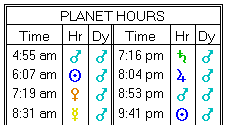
This object shows the planets of each planetary hour of the current day, starting at dawn and ending with dawn of the following day.
Nakshatras
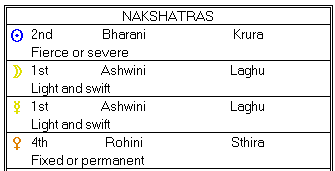
This shows the Nakshatras (Vedic lunar divisions) according to the default sidereal zodiac. The names and types of the mansions are given, as well as a few keywords describing the attributes of the mansion.
Chinese Mansions
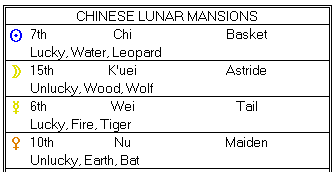
This shows the Chinese Lunar Mansion occupied by each chart point. These mansions are divisions in right ascension, the boundaries of which are defined by the positions of certain fixed stars. The Chinese and English names of the mansion are given, as well as a few keywords describing the attributes of the mansion.
Chinese Year Pillar

This shows the polarity, element (of the five Chinese Elements) and the animal of the current lunar year.
